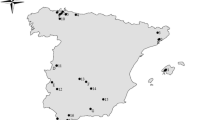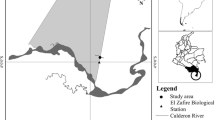Abstract
The importance of the olive tree phenology from agricultural and ecological point of view justifies the need to carry out phenological studies at local and regional scales. Furthermore, flowering phenology in the olive tree (Olea europaea L.) is an important indicator of climatic change in the Mediterranean region. In this paper, we study the effects of altitude and the exposure of crown-flowering branches on the flowering phenology of the olive tree. The study was carried out from 2009 to 2012 at eight sites of Cornicabra olive cultivar in central Spain (Toledo province, Castilla-La Mancha region), at altitudes between 440 and 875 m above sea level, since most olive groves in central Spain are to be found in this altitude range. Flowering phenology was also compared in two olive groves located at the same site and elevation; one in a flat area and the other on a north-facing hillside. Results revealed a significant correlation between altitude and flowering start-date: for each 100 m increase in altitude, flowering started 2.5 days later. Analysis of individual flowering branches of the same tree showed that preflowering and flowering started several days later on north-facing compared to south-facing branches. Olive trees growing on a north-facing hillside started the preflowering stage with some delay with respect to those growing in flat areas. Finally, taking onset of flowering as the variable, a hierarchical cluster analysis enabled olive-groves to be classified by flowering sequence across an altitudinal gradient.







Similar content being viewed by others
References
Aguilera F, Ruiz L (2009) Study of the floral phenology of Olea europaea L. in Jaén province (SE Spain) and its relation with pollen emission. Aerobiologia 25(4):217–225
Aguilera F, Ruiz L (2012) Altitudinal fluctuations in the olive pollen emission: an approximation from the olive groves of the south-east Iberian Peninsula. Aerobiologia 28:403–411
Aguilera F, Ruiz L, Fornaciari M, Romano B, Galán C, Oteros J, Ben Dhiab A, Msallem M, Orlandi F (2013) Heat accumulation period in the Mediterranean region: phenological response of the olive in different climate areas (Spain, Italy and Tunisia). Int J Biometorol. doi:10.1007/s00484-013-0666-7
Avolio E, Orlandi F, Bellecci C, Fornaciari M, Federico S (2012) Assessment of the impact of climate change on the olive flowering in Calabria (southern Italy). Theor Appl Climatol 107(3–4):531–540
Bader MY, Ruijten JJA (2008) A topography-based model of forest cover at the alpine tree line in the tropical Andes. J Biogeogr 35:711–723
Barranco D, Rallo L (2000) Olive cultivars in Spain. HortTechnol 10:107–110
Bonofiglio T, Orlandi F, Sgromo C, Romano B, Fornaciari M (2008) Influence of temperature and rainfall on timing of olive (Olea europaea) flowering in southern Italy. N Z J Crop Hortic 36:59–69
Bonofiglio T, Orlandi F, Sgromo C, Romano B, Fornaciari M (2009) Evidences of olive pollination date variations in relation to spring temperature trends. Aerobiologia 25:227–237
Camargo MGG, Souza RM, Reys P, Morellato LPC (2011) Effects of environmental conditions associated to the cardinal orientation on the reproductive phenology of the cerrado savanna tree Xylopia aromatica (Annonaceae). An Acad Bras Cienc 83(3):1007–1019
Cesaraccio C, Canu A, Pellizzaro G, Sirca C (2006) A detailed description of flowering stages in olive tree in relation to side tree crown exposure. In: Proceedings of the 17th conference on biometeorology and aerobiology, 21–25 May, San Diego, California (EEUU)
Chmielewski FM (2003) Phenology and agriculture. In: Schwartz MD (ed) Phenology: an integrative environmental science. Kluwer Academic Publ, Dordrecht, pp 505–522
Chytrý M, Tichý L (1998) Phenological mapping in a topographically complex landscape by combining field survey with an irradiation model. Appl Veg Sci 1:225–232
Connor DJ, Fereres E (2005) The physiology of adaptation and yield expression in olive. Hortic Rev 31:155–229
Cornelius C, Petermeier H, Estrella N, Menzel A (2011) A comparison of methods to estimate seasonal phenological development from BBCH scale recording. Int J Biometeorol 55:867–877
Cufar K, De Luis M, Saz M, Crepinsek Z, Kajfez-Bogataj L (2012) Temporal shifts in leaf phenology of beech (Fagus sylvatica) depend on elevation. Trees 26:1091–1100
Davi H, Gillmann M, Ibanez T, Cailleret M, Bontemps A, Fady B, Lefèvre F (2011) Diversity of leaf unfolding dynamics among tree species: new insights from a study along an altitudinal gradient. Agric For Meteorol 151:1504–1513
De la Rosa R, Rallo L, Rapoport HF (2000) Olive floral bud growth and starch content during winter rest and spring budbreak. HortScience 35(7):1223–1227
De Melo-Abreu JP, Barranco D, Cordeiro AM, Tous J, Rogado BM, Villalobos FJ (2004) Modelling olive flowering date using chilling for dormancy release and thermal time. Agric For Meteorol 125(1–2):117–127
Denney JO, McEachern GR, Griffiths JF (1985) Modeling the thermal adaptability of the olive (Olea europaea L.) in Texas. Agric For Meteorol 35:309–327
Díaz de la Guardia C, Alba F, Trigo MM, Galán C, Ruíz L, Sabariego S (2003) Aerobiological analysis of Olea europaea L. pollen in different localities of southern Spain. Grana 42:234–243
Emberlin J, Jaeger S, Dominguez-Vilches E, Galán C, Hodal L, Mandrioli P, Rantio A, Savage M, Spieksma FT, Barlett C (2000) Temporal and geographical variations in grass pollen seasons in areas of western Europe: an analysis of season dates at sites of the European pollen information system. Aerobiologia 16:373–379
Fernández-Escobar R, Moreno R, Sánchez-Zamora MA (2004) Nitrogen dynamics in the olive bearing shoot. HortScience 39(6):1406–1411
Galán C, García-Mozo H, Cariñanos P, Alcázar P, Domínguez-Vilches E (2001) The role of temperature in the onset of the Olea europaea L. pollen season in southwestern Spain. Int J Biometeorol 45:8–12
Galán C, García-Mozo H, Vázquez L, Ruiz-Valenzuela L, Díaz de la Guardia C, Trigo-Pérez M (2005) Heat requirement for the onset of the Olea europaea L. pollen season in several places of Andalusia region and the effect of the expected future climate change. Int J Biometeorol 49(3):184–188
Galán C, García-Mozo H, Vázquez L, Ruiz L, Díaz de la Guardia C, Domínguez-Vilches E (2008) Modeling olive crop yield in Andalusia, Spain. Agron J 100(1):98–104
García-Mozo H (2011) The use of aerobiological data on agronomical studies. Ann Agric Environ Med 18:159–164
García-Mozo H, Galán C, Vázquez L (2006) The reliability of geostatistic interpolation in olive field floral phenology. Aerobiologia 22:97–108
García-Mozo H, Pérez-Badía R, Galán C (2008) Aerobiological and meteorological factors’ influence on olive (Olea europaea L.) crop yield in Castilla-La Mancha (Central Spain). Aerobiologia 24:13–18
García-Mozo H, Mestre A, Galán C (2010) Phenological trends in southern Spain: a response to climate change. Agric For Meteorol 150:575–580
Gómez-Casero MT, Galán C, Domínguez-Vilches E (2007) Flowering phenology of mediterranean Quercus species in different locations (Córdoba, SW Iberian Peninsula). Acta Bot Malacitana 32:127–146
Gucci R, Cantini C (2000) Pruning and training systems for modern olive growing. Csiro Publishing, Collingwood, VIC
Hackett WP, Hartmann HT (1963) Morphological development of buds of olive as related to low temperature requirement for inflorescence formation. Bot Gaz 124:385–387
Hartmann HT, Whisler JE (1975) Flower production in olive as influenced by various chilling temperature regimes. J Am Soc Hortic Sci 100:670–674
Jato V, Rodríguez-Rajo FJ, Méndez J, Aira MJ (2002) Phenological behaviour of Quercus in Ourense (NW Spain) and its relationship with the atmospheric pollen season. Int J Biometeorol 46:176–184
Jochner SC, Sparks TH, Estrella N, Menzel A (2012) The influence of altitude and urbanization on trends and mean dates in phenology (1980–2009). Int J Biometeorol 56:387–394
Kumral NA, Kovanci B, Akbudak B (2005) Pheromone trap catches of the olive moth, Prays oleae (Bern.) (Lep., Plutellidae) in relation to olive phenology and degree-day models. J Appl Entomol 129(7):375–381
Larcher W (2006) Altitudinal variation in flowering time of lilac (Syringa vulgaris L.) in the Alps in relation to temperatures. Oesterr Akad Wiss Math-Naturwiss Kl Sitzungsber Abt I 212:3–18
Maxime C, Hendrik D (2011) Effects of climate on diameter growth of co-ocurring Fagus sylvatica and Abies alba along an altitudinal gradient. Trees 25:265–276
Menzel A, Sparks TH, Estrella N, Koch E, Aasa A, Ahas R, Alm-Kübler D, Bissolli P, Braslavská O, Briede A, Chmielewski FM, Crepinsek Z, Curnel Y, Dahl A, Defila C, Donnelly A, Filella Y, Jatczak K, Mage F, Mestre A, Nordli O, Peñuelas J, Pirinen P, Remisová V, Scheifinger H, Striz M, Susnik A, Van Vliet AJH, Wielgolaski F, Zach S, Zust A (2006) European phenological response to climate change matches the warming pattern. Glob Chang Biol 12:1969–1976
Ohashi Y, Kawakami H, Shigeta Y, Ikeda H, Yamamoto N (2012) The phenology of cherry blossom (Prunus yedoensis “Somei-yoshino”) and the geographic features contributing to its flowering. Int J Biometeorol. doi:10.1007/s00484-011-0496-4
Orlandi F, Fornaciari M, Romano B (2002) The use of phenological data to calculate chilling units in Olea europaea L. in relation to the onset of reproduction. Int J Biometeorol 46:2–8
Orlandi F, García-Mozo H, Vazquéz L, Romano B, Domínguez E, Galán C, Fornaciari M (2004) Phenological olive chilling requirements in Umbria (Italy) and Andalusia (Spain). Plant Biosyst 138(2):111–116
Orlandi F, Ruga L, Romano B, Fornaciari M (2005a) An integrated use of aerobiological and phenological data to analyse flowering in olive groves. Grana 44:51–56
Orlandi F, Ruga L, Romano B, Fornaciari M (2005b) Olive flowering as an indicator of local climatic changes. Theor Appl Climatol 81:169–176
Orlandi F, Msallem M, Bonofiglio T, Ben Dhiab A, Sgromo C, Romano B, Fornaciari M (2010) Relationship between olive flowering and latitude in two Mediterranean countries (Italy and Tunisia). Theor Appl Climatol 102:265–273
Pellerin M, Delestrade A, Mathieu G, Rigault O, Yoccoz NG (2012) Spring tree phenology in the Alps: effects of air temperature, altitude and local topography. Eur J For Res. doi:10.1007/s10342-012-0646-1
Privé JP, Sullivan JA, Proctor JTA, Allen OB (1993) Climate influences vegetative and reproductive components of primocane-fruiting red raspberry cultivars. J Am Soc Hortic Sci 118(3):393–399
Rallo L, Martín GC (1991) The role of chilling in releasing olive floral buds from dormancy. J Am Soc Hortic Sci 116(6):1058–1062
Rivas-Martínez S (2007) Mapa de series, geoseries y geopermaseries de vegetación de España. Itinera Geobot 17:1–435
Rivas-Martínez S, Díaz TE, Fernández-González F, Ízco J, Loidi J, Lousã M, Penas A (2002) Vascular plant communities of Spain and Portugal. Addenda to the syntaxonomical checklist of 2001. Itinera Geobot 15:1–922
Sáenz C, Gutiérrez M, Alcolado V (2003) Fenología, aerobiología y producción del olivar en Almodóvar del Campo (Castilla-La Mancha). An Jard Bot Madr 60(1):73–81
Sanz-Cortés F, Martínez-Calvo J, Badenes ML, Bleiholder H, Hack H, Llácer G, Meier U (2002) Phenological growth stages of olive trees (Olea europaea). Ann Appl Biol 140:151–157
Shijo J, Reddy C, Pattanaik C, Sudhakar S (2008) Distribution of plant communities along climatic and topographic gradients in Mudumalai Wildlife Sanctuary (southern India). Biol Lett 45:29–41
Spano D, Cesaraccio C, Duce P, Snyder RL (1999) Phenological stages of natural species and their use as climate indicators. Int J Biometeorol 42:124–133
Tang Z, Fang J (2006) Temperature variation along the northern and southern slopes of Mt. Taibai, China. Agric For Meteorol 139:200–207
Vázquez FM (1998) Semillas del género Quercus L. (Biología, Ecología y Manejo). Servicio de Investigación y Desarrollo Tecnológico. Junta de Extremadura. Consejería de Agricultura y Comercio
Wang CT, Long RJ, Wang QJ, Ding LM, Wang MP (2007) Effects of altitude on plant-species diversity and productivity in an alpine meadow, Qinghai-Tibetan plateau. Aust J Bot 55:110–117
Wang Y, Li X, Dawadi B, Eckstein D, Liang E (2013) Phenological variation in height growth and needle unfolding of Smith fir along and altitudinal gradient on the southeastern Tibetan Plateau. Trees. doi:10.1007/s00468-012-0793-5
Weinberger JH (1950) Chilling requirements of peach varieties. Proc Am Soc Hortic Sci 56:122–128
Ziello C, Estrella N, Kostova M, Koch E, Menzel A (2009) Influence of altitude on phenology of selected plant species in the Alpine region (1971–2000). Clim Res 39:227–234
Acknowledgments
The authors are grateful to the Consejería de Educación y Ciencia de la Junta de Comunidades de Castilla-La Mancha for financial support provided through project POIC10-0302-2695.
Author information
Authors and Affiliations
Corresponding author
Additional information
Communicated by J. Lin.
Rights and permissions
About this article
Cite this article
Rojo, J., Pérez-Badia, R. Effects of topography and crown-exposure on olive tree phenology. Trees 28, 449–459 (2014). https://doi.org/10.1007/s00468-013-0962-1
Received:
Revised:
Accepted:
Published:
Issue Date:
DOI: https://doi.org/10.1007/s00468-013-0962-1




